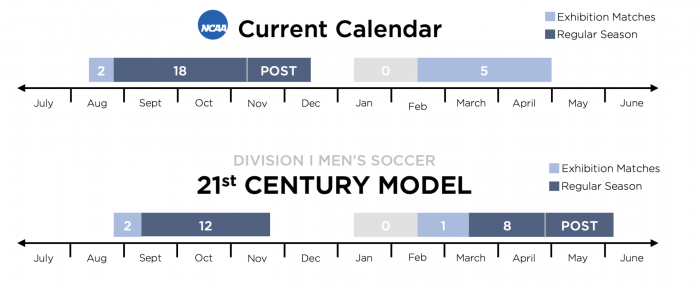It didn’t take the Indiana Men’s Soccer program more than one day of training this fall before the college sports world found out that there would be no fall season at all.
“On our first day of training, we were definitely riding the high,” senior Joe Schmidt said. “And then a few hours later, it was ‘by the way, you guys aren’t playing any games this fall.’ It was definitely tough news.”
While 2020 has brought forth more disheartening news than not, the Indiana Men’s Soccer program now has a chance to be a part of history.
With the NCAA’s recent announcement that fall season championships will have the opportunity to instead be held in the spring, a Big Ten soccer season suddenly looks like a real possibility.
Should IU go on to play this spring, college soccer would be inching closer to making permanent changes to the structure of play. For years, leaders across the sport, including IU Head Coach Todd Yeagley and Maryland Head Coach Sasho Cirovski, have advocated for lengthening their sport’s schedule into a full academic year, rather than attempting to fit an entire season into the span of a few months.

The 21st Century Model would elongate the college soccer season into a full academic year.
The number of reasons for the potential schedule changes is vast, but above all, the proposed “21st Century Model” is built with the health and well-being of student athletes at the forefront. By maximizing the total number of midweek competitions to three while spreading competitions throughout an entire academic year, athletes would be allotted more mental and physical rest between competitions and training sessions. By elongating the season and moving the sport’s postseason from November to May, the total number of competitions would still only be slightly reduced, from 25 to 23.
The legislation was proposed to the NCAA last year, but when COVID-19 came crashing down, conversations about potential changes paused. Now, there’s an opportunity to begin discussing it once again.
“Most importantly this spring would give us a really good view of what it would look like with some of the different challenges that other schools might have with some of the logistics,” IU Head Coach Todd Yeagley said. “This would be a good beta test for that.”
Those logistical challenges are not to be quickly looked past. For many schools including those in Indiana, beginning competition as early as February would also mean competing in freezing temperatures. Besides the obvious obstacles for the players and coaches themselves, maintaining a real grass playing surface during the winter months is a separate challenge altogether.
While the scheduling changes would certainly help to restore the “student” in “student-athlete” by allowing players to focus on their studies, the athletic advantages are apparent as well. Proponents of the model believe that the full-year format more closely resembles how all professional leagues are structured across the globe. For a program as prestigious as Indiana with Hoosiers that move on to play professionally every year, everyone involved would be better prepared.
“That’s what the rest of the world does in our sport,” Yeagley said. “We’re trying to have less compression in one semester.”
Regardless of what the future may hold, Indiana has not wavered, in spite of everything, expecting to compete at some point during the 2020-21 year. It’ll just be a matter of “when.”
“It’s not like we’re not preparing for any opponent,” Schmidt said. “It’s just been delayed a little bit.”

